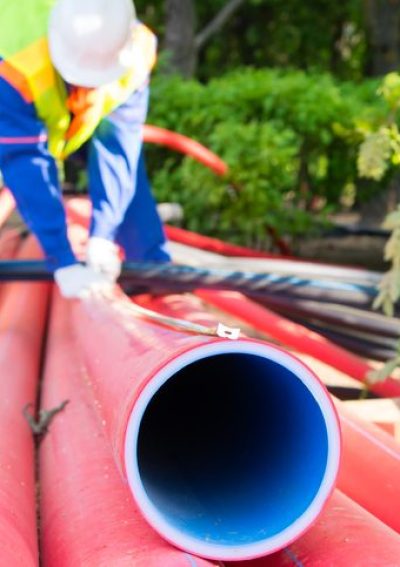Vinyl Chloride
Vinyl chloride is a volatile chemical used in plastic manufacturing. A 2023 train derailment in Ohio released this chemical into the surrounding environment, impacting nearby communities. Exposure to vinyl chloride has serious health implications and has been linked to an increased risk of cancer.

What Is Vinyl Chloride?
Vinyl chloride is a volatile, flammable chemical with a sweet odor. It doesn’t occur naturally and is produced industrially, mainly to make polyvinyl chloride. PVC is a commonly used hard plastic used to make pipes and other plastic products.
Vinyl chloride is found in tobacco smoke as a product of combustion. It can also form when chlorinated chemicals break down in soil or water. Other names for vinyl chloride include ethylene monochloride, chloroethane and chloroethylene.
Vinyl chloride is a carcinogen and threat to environmental health. The highest levels of vinyl chloride in the environment are usually found near vinyl factories or in places where there’s been a toxic chemical spill.
Why Is Vinyl Chloride Dangerous?
When heated, vinyl chloride can release dangerous chemicals, including carbon monoxide, hydrogen chloride and phosgene fumes. Inhaling high levels of vinyl chloride can cause difficulty breathing or asphyxiation. Exposure to heat may cause fire or explosions.
Most vinyl chloride exposure happens via breathing it in or drinking contaminated water, though vinyl chloride can also be absorbed through the skin. While extreme and prolonged exposure can have severe health consequences, short-term adverse reactions to vinyl chloride exposure typically clear up.
- Dizziness
- Headache
- Irritation of the eyes, nose, throat and lungs
- Nausea Sleepiness
- Tingling in the arms and legs
- Worsening asthma symptoms or difficulty breathing
In 2023, a train derailment near East Palestine, Ohio, caused a serious spill of toxic chemicals that included vinyl chloride. Common symptoms residents reported are anxiety, bloody noses, burning of the skin, coughing, eye irritation, fatigue, headaches, rashes and vomiting. Many people were diagnosed with chemical bronchitis and several were hospitalized.
Facing short- and potentially long-term adverse health effects from the Ohio train derailment, those exposed are filing lawsuits. Norfolk Southern Corporation, which owns the derailed train, is facing multiple lawsuits alleging carelessness and negligence are at fault for the derailment.
Cancers Associated With Vinyl Chloride Exposure
While short-term effects such as industrial bronchitis typically resolve within a few weeks or months with treatment, long-term vinyl chloride effects can take decades to appear. Vinyl chloride is a carcinogen, and exposure increases the risk of certain cancers, such as cancer of the liver, lungs and brain. It’s also linked to lymphoma and leukemia.
Long-term exposure can cause changes to the immune system that make it harder to fight off serious illnesses. Cancers associated with long-term exposure to vinyl chloride include:
- Brain cancer
- Hepatic angiosarcoma (a rare form of liver cancer)
- Hepatocellular carcinoma (primary liver cancer)
- Leukemia
- Lung cancers
- Lymphoma
Exposure to high levels of vinyl chloride can cause miscarriage, birth defects and poor sperm quality. These effects are linked to air exposure of more than 1,000,000 parts per billion, though there is no safe exposure level for vinyl chloride.
Vinyl chloride impacts the central and peripheral nervous systems, causing tingling and sensory issues in extremities, such as hands and fingers. Chronic exposure to vinyl chloride can cause vinyl chloride disease. Symptoms include a cold sensation in hands, whitening of fingertips, hardened or coarse skin, fingertip shortening and other bone abnormalities.
How Is Vinyl Chloride Used?
Vinyl chloride is used to make many plastic items such as polyvinyl chloride plastic. These plastics are used in medical supplies, including IV bags, kitchenware such as cooking utensils, waterproof coatings on raincoats and certain types of clothing. Vinyl chloride is used in car interiors, and vinyl chloride levels in the air within passenger areas can be higher in new cars.
PVC pipes used to transport drinking water in homes throughout the U.S. are the subject of some debate. As the Scientific American recently reported, a federal plan to replace lead pipes with plastic has been met with disagreement about the safety of plastic pipes. Industry representatives and sanitation organizations contend plastic piping is safe for drinking water, while a group of 19 health and environmental advocacy organizations support removing lead, but oppose plastic pipes over health concerns, including vinyl chloride leaching. They recommend the use of copper pipes instead.
How Are People Exposed to Vinyl Chloride?
Exposure to vinyl chloride occurs through contaminated soil, water or air. Toxic chemical spills from train derailments, factory explosions and fires, chemical storage leaks and emissions from production facilities also cause exposure. Products containing vinyl chloride can emit gases and seep chemicals into drinking water. Vinyl chloride can be inhaled, ingested and absorbed through the skin.
One historic example of vinyl chloride exposure happened at Camp Lejeune, a military base in North Carolina. Both on- and off-base chemical spills led to vinyl chloride contamination, exposing as many as 1 million people who lived and worked at Camp Lejeune from 1953 to 1987. A significant contributor to off-base contamination was a nearby dry cleaner’s unsafe waste-disposal practices. Additional chemicals involved in the contamination included trichloroethylene, tetrachloroethylene and benzene.
Drinking, washing dishes and clothing, showering and bathing in contaminated water led to higher than average rates of cancer, including bladder, breast, cervical, liver and pancreatic cancers. Rates of Hodgkin lymphoma, leukemia, multiple myeloma, miscarriages and serious birth defects were also higher compared to the general population. Exposure to vinyl chloride also increased the risk of certain childhood cancers.
Occupational Exposure
Exposure to vinyl chloride through workplace contamination has led to stricter regulations surrounding the chemical. The Occupational Safety and Health Administration standard of workplace regulations dictate that employers must measure and monitor levels of vinyl chloride in the workplace.
OSHA also states that no employee can have contact with liquid vinyl chloride. Employers must provide hazard training for workers and post warning signs where vinyl chloride is used and on containers of the chemical.
A case of occupational vinyl exposure that raised awareness of the risks to workers happened in Kentucky in 1970. Four workers at a plant involved in the polymerization of vinyl chloride were exposed to high levels of the chemical. They each developed a rare type of cancerous tumor on the liver called angiosarcoma. Documentation of exposure and the resultant cancer diagnoses led to the worldwide recognition of vinyl chloride as a carcinogen and stricter workplace limitations.
Environmental Exposure
Environmental exposure to vinyl chloride occurs through contamination of the air, soil and water. Leaks at landfills, spills, accidents and the breakdown of certain chemicals in the soil cause contamination.
In the recent Ohio train derailment, vinyl chloride was intentionally burned off to prevent an explosion, causing contaminated smoke to drift through the surrounding area. In a previous derailment in Paulsboro, New Jersey, in 2012, vinyl chloride in the air caused short-term difficulty breathing, dizziness, headaches, nausea and nose, throat and eye irritation. Long-term effects of this incident have yet to be determined.
In Minnesota, water contamination has occurred near landfill sites. Groundwater concentrations reached 22,000 parts per billion and drinking water levels reached 3.1 ppb. Federal standards require that vinyl chloride levels not exceed 2 ppb. Exposure to even low levels over long periods of time can increase cancer risks.
Consumer Exposure
Consumers can be exposed to vinyl chloride through inhalation of tobacco smoke and emissions from new vinyl products inside residences, cars, schools and office buildings. New housewares, toys, upholstery and furniture can all release vinyl chloride. New vinyl components of car interiors release the chemical at higher-than-normal concentrations.
PVC products, including plastic spatulas, sieves, food packaging and containers, are considered low-risk items, but may have traces of vinyl chloride. Advocacy groups such as the Breast Cancer Prevention Partners advise people to limit their use.
Vinyl chloride may also enter homes from contaminated soil through the house’s foundation. Well water can also be contaminated.
What Should I Do If I’m Exposed?
If you’re exposed to vinyl chloride, leave the source of exposure as soon as possible. Remove clothing that came in contact with the chemical. If your skin has come in contact with the chemical, submerge the affected skin in warm water right away. Wash with a very gentle soap and rinse carefully.
Flush your eyes with clean water for at least 30 minutes. However, if evaporation of vinyl chloride has caused frostbite or irritation of the eyes, do not flush your eyes. Seek immediate medical attention.
Anyone with acute exposure who experiences dizziness, loss of bodily control (ataxia), difficulty breathing or coma should be taken to a hospital immediately. People in severe distress may appear to have symptoms similar to intoxication.
20 Cited Research Articles
Consumernotice.org adheres to the highest ethical standards for content production and references only credible sources of information, including government reports, interviews with experts, highly regarded nonprofit organizations, peer-reviewed journals, court records and academic organizations. You can learn more about our dedication to relevance, accuracy and transparency by reading our editorial policy.
- Trombly, M. (2023, March 7). Headaches, coughing, burning of the skin: Symptoms Ohio residents have experienced after toxic train derailment. Retrieved from https://www.usatoday.com/story/news/nation/2023/03/06/east-palestine-residents-health-norfolk-southern-train-derailment/11415726002/
- Bendix, A. & Lozano, A.V. (2023, February 25). Residents near Ohio train derailment diagnosed with ailments associated with chemical exposure, including bronchitis. Retrieved from https://www.nbcnews.com/health/health-news/ohio-derailment-chemicals-people-diagnosed-bronchitis-rcna71839
- Whitmer, M. (2023, February 23). Ohio Train Derailment: Toxic Chemical Lawsuits Filed. Retrieved from https://www.consumernotice.org/news/ohio-train-derailment-chemical-lawsuits/
- Beier, J. (2023, February 20). How vinyl chloride, chemical released in the Ohio train derailment, can damage the liver – it’s used to make PVC plastics. Retrieved from https://dom.pitt.edu/how-vinyl-chloride-chemical-released-in-the-ohio-train-derailment-can-damage-the-liver-its-used-to-make-pvc-plastics/
- Ohio Department of Health. (2023, February 7). Vinyl Chloride: Answers to Frequently Asked Questions. Retrieved from https://odh.ohio.gov/wps/wcm/connect/gov/ff9d920b-59ae-43b0-a47e-5ec0ddc4606d/vinyl-chloride_20171211.pdf?MOD=AJPERES&CONVERT_TO=url&CACHEID=ROOTWORKSPACE.Z18_K9I401S01H7F40QBNJU3SO1F56-ff9d920b-59ae-43b0-a47e-5ec0ddc4606d-ooJM1oP
- National Cancer Institute. (2022, November 3). Vinyl Chloride. Retrieved from https://www.cancer.gov/about-cancer/causes-prevention/risk/substances/vinyl-chloride
- Lloyd, R. (2022, August). Replacing Lead Water Pipes with Plastic Could Raise New Safety Issues. Retrieved from https://www.scientificamerican.com/article/replacing-lead-water-pipes-with-plastic-could-raise-new-safety-issues/
- United States Environmental Protection Agency. (2020, March). Vinyl Chloride. Retrieved from https://www.epa.gov/sites/default/files/2020-05/documents/vinyl_chloride_march_26_2020.pdf
- Breast Cancer Prevention Partners. (2019). Vinyl Chloride. Retrieved from https://www.bcpp.org/resource/vinyl-chloride/
- Communications Workers of America. (2017). Vinyl Chloride and the Workplace. Retrieved from https://cwa-union.org/national-issues/health-and-safety/health-and-safety-fact-sheets/vinyl-chloride-and-workplace
- Wisconsin Department of Health Services. (2016, November 11). Vinyl Chloride. Retrieved from https://www.canada.ca/en/environment-climate-change/services/management-toxic-substances/list-canadian-environmental-protection-act/vinyl-chloride.html
- Government of Canada. (2016, November 1).Toxic substances list: vinyl chloride. Retrieved from https://www.canada.ca/en/environment-climate-change/services/management-toxic-substances/list-canadian-environmental-protection-act/vinyl-chloride.html
- Minnesota Department of Health. (2016, September). Vinyl Chloride and Drinking Water. Retrieved from https://www.health.state.mn.us/communities/environment/risk/docs/guidance/gw/vinylchlorideinfo.pdf
- Delaware Health and Social Services. (2015, January). Vinyl Chloride. Retrieved from https://dhss.delaware.gov/dph/files/vinylchlfaq.pdf
- New Jersey Department of Health. (2014, September 5). Paulsboro Train Derailment and Vinyl Chloride Release, November 30, 2012 Health Survey Findings and Air Quality Impacts. Retrieved from https://www.nj.gov/health/ceohs/documents/eohap/haz_sites/gloucester/train_derail/factsheet.pdf
- New York State Department of Health. (2014, January). Tenant Notification Fact Sheet for Vinyl Chloride. Retrieved from https://www.health.ny.gov/environmental/indoors/air/contaminants/vinyl_chloride.htm
- New Jersey Department of Health. (2010, November). Hazardous Substances Fact Sheet: Vinyl Chloride. Retrieved from https://nj.gov/health/eoh/rtkweb/documents/fs/2001.pdf
- Agency for Toxic Substances and Disease Registry. (n.d.). Medical Management Guidelines for Vinyl Chloride. Retrieved from https://wwwn.cdc.gov/TSP/MMG/MMGDetails.aspx?mmgid=278&toxid=51
- National Capital Poison Center. (n.d.). What is vinyl chloride? Retrieved from https://www.poison.org/articles/vinyl-chloride
- Occupational Safety and Health Administration. (n.d.). Vinyl chloride. Retrieved from https://www.osha.gov/laws-regs/regulations/standardnumber/1910/1910.1017
Calling this number connects you with a Consumer Notice, LLC representative. We will direct you to one of our trusted legal partners for a free case review.
Consumer Notice, LLC's trusted legal partners support the organization's mission to keep people safe from dangerous drugs and medical devices. For more information, visit our partners page.
844-526-0648
